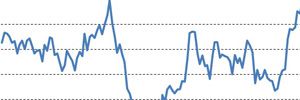 The construction industry continued to experience recovery in February following the 17-month low recorded in December 2014 by Markit and the Charted Institute of Purchasing & Supply (CIPS).
The construction industry continued to experience recovery in February following the 17-month low recorded in December 2014 by Markit and the Charted Institute of Purchasing & Supply (CIPS).
According to the latest Markit/CIPS Construction PMI, output growth accelerated throughout last month, driven by the fastest increase in new orders since October 2014. Higher levels of activity were seen across construction – with residential construction continuing to drive the industry – taking the seasonally adjusted PMI up to 60.1 in February, marking an unexpected increase from January’s 59.1.
Tim Moore, senior economist at Markit and author of the Construction PMI, said:
“The latest survey highlights renewed vitality within the UK construction sector, as output growth picked up further from the soft patch seen at the end of 2014.”
Survey respondents generally attributed increasing output levels to strong workloads and increased spending among clients. Construction companies linked their new business to improving economic conditions and increased confidence, although some noted uncertainties related to the outcome of the General Election in May.
The increased activity that was recorded has also further boosted job creation in the construction industry, although at its least marked pace since December 2013. Meanwhile, sub-contractor usage also rose at an accelerated pace in February, leading to another steep reduction in the availability of sub-contractors. This has continued the recent trend of increasing rates charged by sub-contractors, with the latest increase being the fastest since the survey began almost 18 years ago.
David Noble, group chief executive officer at CIPS, said:
“The construction sector is awash with positive sentiment, rejecting wholeheartedly the downbeat end to last year, with the steepest rise in output activity for four months. The good fortune comes in threes – as respondents report a rise in staffing levels, higher levels of new orders and rising rates for sub-contractors.
“Clients are ready to spend, resulting in rising employment levels, but tempered by continuing skills shortages now seen for a number of months. Sub-contractors have been the winners; their rising rates evidence of continued demand for their capacity and the strongest since records began.”
The latest data also pointed to worsening supply-chain pressures across the sector, with vendor delivery times lengthening to the greatest degree since October 2014.




